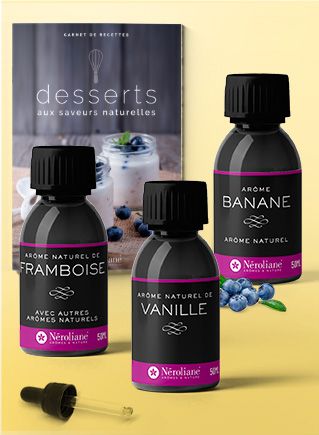Discover the latest natural organic flavours!
I discoverHow do you add vanilla flavour to your recipes?

Are you a professional?
Access exclusive benefits by creating your pro account at Neroliane. Enjoy an immediate 15% discount on all your purchases!
Are you a professional?
Access exclusive benefits by creating your pro account at Neroliane. Enjoy an immediate 15% discount on all your purchases!
You have bought vanilla flavouring to make delicious preparations, but you are not sure how to incorporate it into your cakes and other creams? This article explains how to add vanilla flavouring to your recipe!
Food flavourings are very easy to use and add a subtle flavour to your food. Among the most popular food flavourings are coffee, lemon, strawberry, bitter almond, etc., and especially vanilla flavouring, which is much more economical than real vanilla beans. One drop too many or too few can nevertheless be enough to disappoint you! Here are a few tips on how to best dose vanilla flavouring, whatever your recipe.
A specific dosage according to the preparation
Vanilla flavouring is commonly used in sweet recipes - in ice creams or frozen preparations, in pastries and in dairy products, especially in yoghurts and yoghurt drinks. We will therefore first focus on these three product categories. Generally speaking, vanilla flavouring is quite concentrated, which is why you should use between 2 and 5% of your total preparation. At Nerolian, the specialists recommend specific doses for each set: to make smooth, subtly flavoured ice creams, start with 3%. Thus, for 20 cl of ice cream, you will incorporate 120 drops of flavouring, or 6 ml. The same applies to dairy products. The dose is slightly higher for pastries, with an optimal dosage of 4%. For 200 grams of preparation, you can incorporate 160 drops of vanilla flavouring, or 8 ml.
All your recipes for biscuits (shortbread, macaroons, madeleines, muffins, etc.), baked goods (brioches, pancakes, waffles, pancakes), cakes (yoghurt, flans, quadruplets, etc.) and other fruity desserts - baked apples, flambéed bananas, etc. - will be all the better with a few drops of vanilla flavouring! You can also spice up your hot chocolate and other coffees with your flavouring, making sure to respect the dosage for dairy products. Remember also that the more your preparations are cooked, the more you need to intensify the flavour. If your cakes, pies and other desserts are going to be baked at a high temperature, the amount of flavouring should also be increased! For example, if you use Neroliane vanilla flavouring, the amount of flavouring varies between 3 and 5% for your baked goods, while the proportion in dairy products and ice cream varies between 2.5 and 3.5%.
Flavour combinations
You can also combine several flavours in one recipe. Vanilla flavouring can be used in savoury recipes in combination with sweet almond, cardamom or hazelnut flavouring. In this case, it is important to reduce the dosage of each flavour by tasting your preparations as you go along. It is possible to incorporate essential oils, such as pink berry or black pepper, which are a delight when combined with vanilla. In your desserts, try combinations such as vanilla flavouring-cocoa flavouring, vanilla flavouring-mimosa flavouring, etc.
Choose natural vanilla flavours
For best results, opt for natural vanilla flavouring as much as possible. According to European legislation, a natural flavour is produced by concentrating, distilling, extracting, fermenting or roasting a vegetable raw material. You can find all kinds - and all qualities - online, in supermarkets and in some specialist shops. Choosing a natural vanilla flavouring ensures that your flavouring is composed of at least 95% vanilla molecules, such as vanillin, for example.











